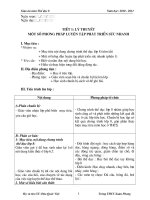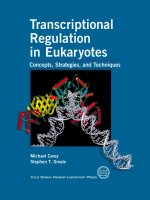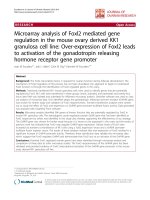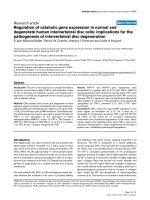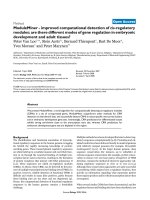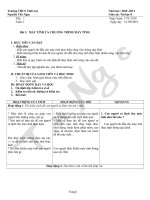Week 8 gene regulation in eukaryotes
Bạn đang xem bản rút gọn của tài liệu. Xem và tải ngay bản đầy đủ của tài liệu tại đây (3.51 MB, 62 trang )
8TH WEEK, BIO-1053
GENE REGULATION IN EUKARYOTES
8th week
General Genetics-BIO1053
Chapter outline
Overview of Eukaryotic Gene Regulation
Control of Transcription Initiation
Chromatin Structure and Epigenetic Effects
Regulation After Transcription
8th week
General Genetics-BIO1053
Overview of eukaryotic gene regulation
Eukaryotes use complex sets of interactions
• Regulated interactions of large networks of genes
• Each gene has multiple points of regulation
Themes of gene regulation in eukaryotes:
• Environmental adaptation in unicellular eukaryotes
• Maintenance of homeostasis in multicellular
eukaryotes
• Genes are turned on or off in the right place and time
• Differentiation and precise positioning of tissues and
organs during embryonic development
8th week
General Genetics-BIO1053
Control of transcription initiation
Three types of RNA polymerases in eukaryotes
• RNA pol I – transcribes rRNA genes
• RNA pol II – transcribes all protein-coding genes
(mRNAs) and micro-RNAs
• RNA pol III – transcribes tRNA genes and some small
regulatory RNAs
8th week
General Genetics-BIO1053
The three polymerases in eukaryotes
These enzymes are
eluted at different salt
concentration during ion
exchange
chromatography
Difference in their
sensitivity to α-amanitin.
Pol I is very insensitive,
Pol II is very sensitive,
Pol III is intermediate
sensitivity
8th week
General Genetics-BIO1053
Comparison of three-dimensional structures of
bacterial and eukaryotic RNA polymerases
cis-acting elements: promoters and
enhancers
Promoters – usually directly adjacent to the gene
• Include transcription initiation site
• Often have TATA box: TATAA(T)AA(T)
• Allow basal level of transcription
Enhancers – can be far away from gene
• Augment or repress the basal level of transcription
trans-acting factors interact with cis-acting
elements to control transcription initiation
Direct effects of
transcription factors:
binding to DNA
Indirect effect of
transcription factors:
protein-protein
interactions
Use of reporter genes to identify
promoters and enhancers in eukaryotes
Use of reporter genes to identify transacting factors in transcriptional regulation
Localization of activator domains using recombinant
DNA constructs
lexA: the bacterial
repressor, contains
only DNA-binding
domain
Yeast promoter
Basal transcription factors
Basal transcription factors assist the binding of RNA pol II
to promoters
Key components of basal factor complex:
• TATA box-binding protein (TBP)
• Bind to TATA box
• First of several proteins to assemble at promoter
• TBP-associated factors (TAFs)
• Bind to TBP assembled at TATA box
RNA pol II associates with basal complex and initiates
basal level of transcription
Basal factors bind to promoters of all
protein-encoding genes
Ordered pathway of
assembly at promoter:
1. TBP binds to TATA box
2. TAFs bind to TBP
3. RNA pol II binds to TAFs
Activators are transcription factors that
bind to enhancers
Increase levels of transcription by interacting directly or
indirectly with basal factors at the promoter
• Stimulate recruitment of basal factors and RNA pol II
to promoters
• Stimulate activity of basal factors already assembled
on promoters
• Facilitate changes in chromatin structure
Binding of activators to enhancers increases
transcriptional levels
Steroid hormones are co-activators
Polypeptides and other molecules that play a role in
transcriptional activation without binding directly to DNA are
called coactivators.
Domains within activators
Activator proteins have two functional domains
Sequence-specific DNA binding domain
• Binds to enhancer
Transcription-activator domain
• Interacts with other transcriptional regulatory proteins
Some activators have a third domain
Responds to environmental signals
• Example - steroid hormone receptors
DNA-binding domains of activator proteins
Interacts with major groove
of DNA
Specific amino acids have
high-affinity binding to
specific nucleotide sequence
The three bestcharacterized motifs:
•Helix-loop-helix (HLH)
•Helix-turn-helix (HTH)
•Zinc finger
Many activators must form dimers to function
Homodimers:
multimeric proteins
made of identical
subunits
Heterodimers:
multimeric proteins
made of nonidentical
subunits
Dimerization domains
are specialized for
polypeptide-polypeptide
interactions
Leucine zippers are a
common dimerization
motif in eukaryotes
Repressors diminish transcriptional activity
Repressor proteins suppress transcription initiation through
different mechanisms:
Some repressors have no effect on basal transcription but
suppress the action of activators
- Compete with activator for the same enhancer
- Block access of activator to an enhancer
Some repressors eliminate virtually all basal transcription
from a promoter
- Block RNA pol II access to promoter
- Bind to sequences close to promoter or distant from
promoter
Repressor proteins that act through
competition with an activator protein
Repressor binds to the same enhancer sequence as the
activator
• Has no effect on the basal transcription level
Repressor proteins that act through quenching
an activator protein
• Type I: Repressor blocks the DNA-binding domain
• Type II: Repressor blocks the activation domain
